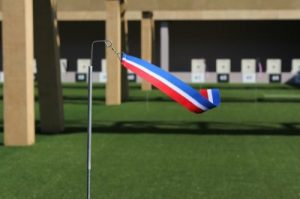WIND & WIND FLAGS

written by Tricia Van Nus.
Reading the wind is where I have had some of my greatest achievements. Both as a coach and a shooter I have always quietly smiled when others have grumbled and fell, ravaged by the wind…..for me – shooting with top focus, aiming off and a “cat watching mouse” approach have always made the experience enjoyable.
That is not to say that I have never felt “blown away” by what lay between the barrel and the target, but I have always felt that elements may have occasionally won the game, or even the set, but never the match!!
For the beginning shooter I hope some of what I have to say can be helpful.
Firstly, no one does consistently well in smallbore shooting without reading or taking notice of the wind flags.
Flags across this country come in a variety of colours, weights and sizes. The ISSF Rules determine the required standard.
Ideally the flag/s should be able to show movement, direction and strength of the wind on the range, and placed in such a situation that the shooters may see at least a few of them.
ARE YOU COLOUR BLIND?
That poses some new and interesting problems. With a number of our male shooters being colour-blind (often not noticed or detected) there are a new set of challenges. Colour-blindness often comes in the red/green combination, making seeing red flags on green grass rather difficult.
One of our most talented shooters in the late 1990’s had this dilemma. He saw the flags and grass almost as one “brownish” mess and it was only after a lot of reading and bit of experimentation, that we discovered that a magenta filter helped him and clarified what was grass and what were flags.
Solution????
Experiment with filters of varying colours until the contrast is visible. Talk to your eye professional.
Watching the flags.
The wind closer to you generally has the most effect on the bullet. So it would seem that the flag/s closest to you are most important. This is normally true but not always. If the wind is coming towards you, the flag farthest away will more often show wind changes first. And of course, differing ranges will have their own little quirks.
Remember your rifle is sighted in for one particular condition (hopefully, after the sighters). Wind changes to that condition will determine where your bullet will go. Say the wind is from 9 o’clock. You are getting 10’s on the target and you’re feeling good. The wind strength increases. The bullet will go right and often a little low (towards 4 o’clock).
So should you
• Hold a little left and a little high for that condition and just shoot? Probably not unless you have been confidently and successfully working on the concept of aiming off in your training (ask your coach about that concept)
• Wait?? Yes briefly – maybe the original condition will come back in a few minutes. Best that you just watch the range conditions and wait for a moment to see what happens. Keep busy with good positive thoughts while you are waiting and watching.
• Change the sights. Should the change seem to be permanent, then use your training knowledge, adjust your sights and fire a very good shot. This will give you valuable information about the wind change.
The condition change I gave is a simple one – just a wind strength increase. However, the wind could have stayed the same velocity but shifted direction a little. More than likely it will do both at the same time! If you have watched and waited, and waited, and waited, then don’t be afraid to utilise the sights!!!! Based on your knowledge gained in training, you will be confident to make good sight corrections. Yes there are going to be times when the changes are very quick and you miss it – stay sharp and focused. Anger and frustration only compounds the effects of the elements.
Remember when the wind blows and/or the rain belts down…
• Keep your thoughts positive and take a diary down with you if you need to record how many clicks you adjust on the sights. Yes – with everything else going on, shooters often forget where they are, and once you are half way into a match (or even a 20 shot card) it is easy to forget where the sighter zero is.
• The other shooters are also in the same range with you – they have their own little challenges happening as well.
• Keep the flag/s in the one quadrant and try for consistency in firing the best shot you can.
• You probably cannot see all the flags on the range, so watch a couple in your bay carefully, rather than all of them haphazardly.
• The shots will move with the wind and the rain……work that to your advantage.
• Rain will often “drop” the shots, just as wind will move them – learn from each shot.
• Keep your shot quality very high – good process has the greatest chance of being good score outcome.
• Use the time before, or in between details, to watch what is happening on the range. Be prepared – see how fast the flags move, or in what general directions.
• Scope one of the “experts” for a bit and see what the flags are doing when they shoot – can you see their pattern??
One last thought that many shooters avoid……
Train in all conditions – wind, rain, hail or sun

